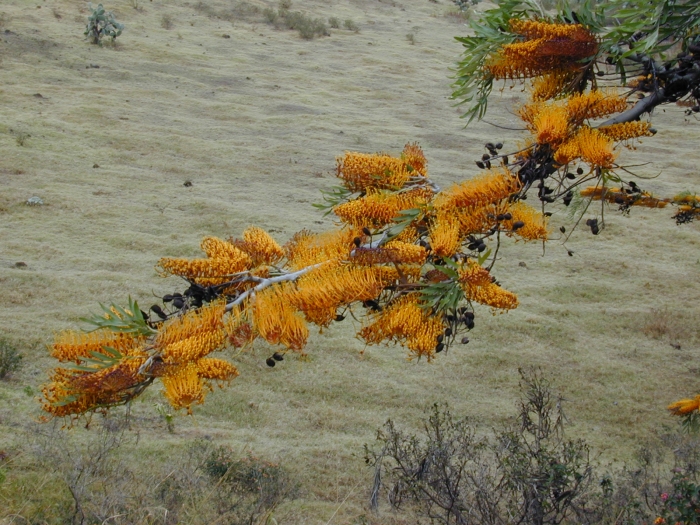Flame Grevillea
(Grevillea excelsior)
Flame Grevillea (Grevillea excelsior)
/
/

Forest and Kim Starr
CC BY 2.0
Image By:
Forest and Kim Starr
Recorded By:
Copyright:
CC BY 2.0
Copyright Notice:
Photo by: Forest and Kim Starr | License Type: CC BY 2.0 | License URL: https://creativecommons.org/licenses/by-sa/2.0/ | Uploader: Starr Environmental | Publisher: Flickr |




























Estimated Native Range
Summary
Grevillea excelsior, commonly known as Flame Grevillea, is an evergreen tree native to the sandy plains and gravelly soils of Southwestern Australia, particularly thriving in open woodlands and scrublands. This species is an erect shrub or small tree that can grow to a height of 1–8 m (3 ft 3 in – 26 ft 3 in). It has a distinctive appearance with usually divided leaves that have linear lobes, and it produces showy clusters of orange flowers that are particularly attractive to nectar-feeding birds and insects.
Flame Grevillea is valued for its ornamental flowers, which bloom from late winter to spring (August to November in its native range), offering a bright splash of color when many other plants are not in flower. The foliage is also noteworthy, with leaves measuring 50–300 mm (2.0–11.8 in) long, divided into two to seven linear lobes, and sometimes divided again. The leaf edges are rolled under, creating a unique texture. The flowers, pale orange on the outside and brighter inside, are arranged in conical to oblong clusters, with a bright orange style that extends from the pistil, which is 20–29 mm (0.79–1.14 in) long. After flowering, the plant produces a hairy follicle 15–22 mm (0.59–0.87 in) long. In cultivation, it is used for its low water needs and ability to thrive in poor soils, making it suitable for xeriscaping and as a feature plant in drought-tolerant gardens. It prefers full sun and well-drained soils. While generally low-maintenance, it can be susceptible to root rot in poorly drained soils and may attract pests such as aphids.CC BY-SA 4.0
Flame Grevillea is valued for its ornamental flowers, which bloom from late winter to spring (August to November in its native range), offering a bright splash of color when many other plants are not in flower. The foliage is also noteworthy, with leaves measuring 50–300 mm (2.0–11.8 in) long, divided into two to seven linear lobes, and sometimes divided again. The leaf edges are rolled under, creating a unique texture. The flowers, pale orange on the outside and brighter inside, are arranged in conical to oblong clusters, with a bright orange style that extends from the pistil, which is 20–29 mm (0.79–1.14 in) long. After flowering, the plant produces a hairy follicle 15–22 mm (0.59–0.87 in) long. In cultivation, it is used for its low water needs and ability to thrive in poor soils, making it suitable for xeriscaping and as a feature plant in drought-tolerant gardens. It prefers full sun and well-drained soils. While generally low-maintenance, it can be susceptible to root rot in poorly drained soils and may attract pests such as aphids.CC BY-SA 4.0
Plant Description
- Plant Type: Tree
- Height: 10-15 feet
- Width: 5-10 feet
- Growth Rate: Moderate
- Flower Color: Orange, Yellow
- Flowering Season: Spring, Summer
- Leaf Retention: Evergreen
Growth Requirements
- Sun: Full Sun
- Water: Low
- Drainage: Medium, Fast
Common Uses
Bee Garden, Bird Garden, Butterfly Garden, Drought Tolerant, Hummingbird Garden, Low Maintenance, Showy Flowers
Natural Habitat
Native to the sandy plains and gravelly soils of open woodlands and scrublands in Southwestern Australia
Other Names
Common Names: Orange Flame Grevillea, Yellow Flame Grevillea
Scientific Names: , Grevillea excelsior, Grevillea eriostachya subsp. excelsior, Hakea excelsior,
GBIF Accepted Name: Grevillea excelsior Diels